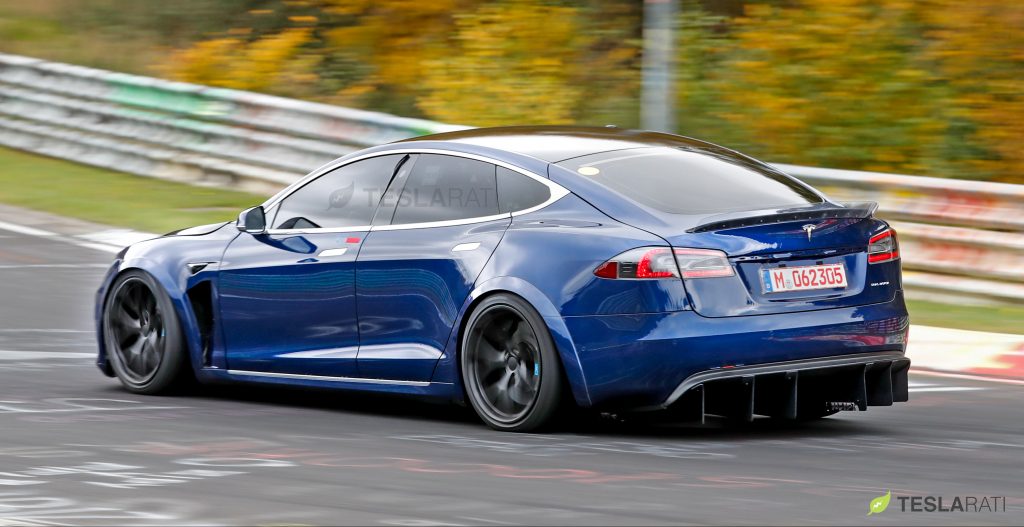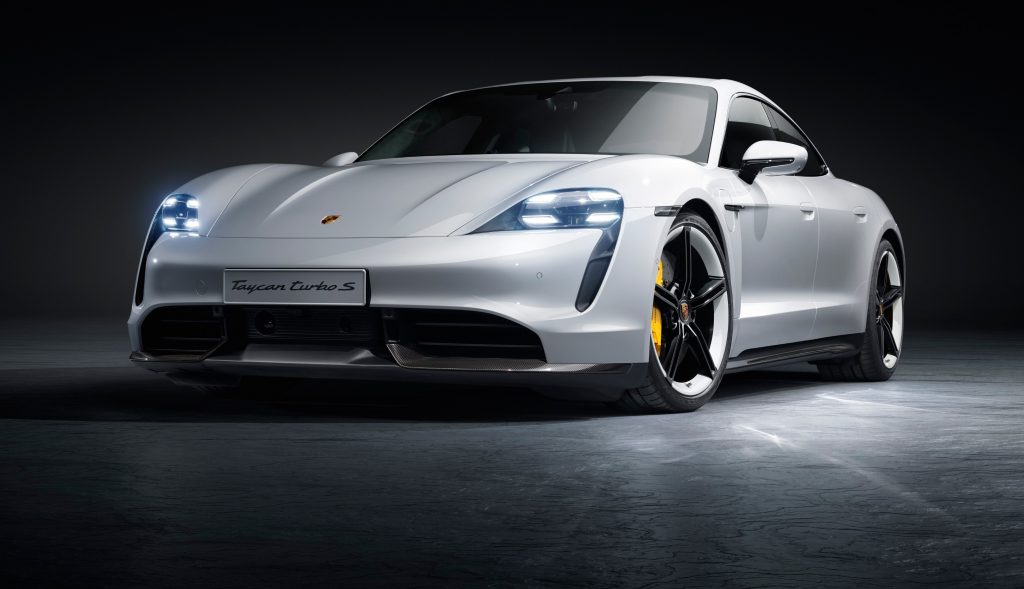

News
Tesla Model S, Porsche Taycan, & other EVs populate list of fastest-accelerating cars in the world
It may seem inconceivable today, but there was once a time when the idea of an electric car having brutally quick acceleration is far-fetched. Prior to the original Tesla Roadster, which broke through the market with its 0-60 mph time of 4.0 seconds, electric vehicles were largely considered as nothing but fancy golf carts. Green, a bit techy, but very little else.
Thanks in no small part to Tesla’s efforts, electricity is widely considered today as the propulsion of choice for tomorrow’s cars. No longer are EVs glorified golf carts. They now represent the best that the auto industry has to offer, and they have garnered a reputation for humbling petrol-powered supercars on the quarter-mile. Even hypercars that are expected to be released in the coming years are, for the most part, electric.
This trend is represented very well in a recent list compiled by UK-based motoring publication Autocar. Established in 1895 and widely considered as the world’s oldest car magazine, Autocar has a prominent voice in auto. And ultimately, this is really what makes the publication’s recent list of fastest-accelerating cars so compelling. This time around, the list is downright populated with electric and electrified cars instead of petrol-powered vehicles.

To make it into the British magazine’s list, a car must boast a 0-60 mph time below 3.0 seconds. They must also be production vehicles. This completely eliminates one-off, hyper-customized ICE-powered drag racers. Each car in Autocar UK‘s list must be frighteningly quick out of the factory. And they are. A lot of them just happened to be electric.
Immediately noticeable in the motoring publication’s list is the Tesla Model S, the Silicon Valley-based company’s flagship sedan. The Raven Tesla Model S Performance remains one of the quickest production vehicles today, sprinting from 0-60 mph in 2.4 seconds. The Porsche Taycan Turbo S, another frighteningly quick electric sedan, also stood proudly on the Autocar UK list. Apart from these two, the Rimac Concept One, arguably one of the first genuinely all-electric supercars in the market, also held a spot in the publication’s rankings.

But the story does not end there. A look at the full rankings from the motoring magazine shows that 9 out of the 16 vehicles mentioned in the publication’s actual list has an electric motor. A special section following the full list of fastest-accelerating cars, which posts upcoming vehicles that will likely dominate in 0-60 mph times, is also dominated by electric vehicles. In fact, all four of the contenders for the next-generation of fastest-accelerating cars in the magazine are all-electric.
With results such as these, it is difficult to argue against the fact that the future of the auto industry is electric. With vehicles like the Tesla Model 3 sedan and Model Y crossover attacking the mainstream market, there is a good chance that EVs will become more and more ubiquitous in the coming years. The time when electric cars are considered as just “cars” is likely at hand, and when this happens, one can bet that an internal combustion engine will be nowhere near the list of fastest-accelerating cars in the world.

News
Tesla starts showing how FSD will change lives in Europe
Local officials tested the system on narrow country roads and were impressed by FSD’s smooth, human-like driving, with some calling the service a game-changer for everyday life in areas that are far from urban centers.

Tesla has launched Europe’s first public shuttle service using Full Self-Driving (Supervised) in the rural Eifelkreis Bitburg-Prüm region of Germany, demonstrating how the technology can restore independence and mobility for people who struggle with limited transport options.
Local officials tested the system on narrow country roads and were impressed by FSD’s smooth, human-like driving, with some calling the service a game-changer for everyday life in areas that are far from urban centers.
Officials see real impact on rural residents
Arzfeld Mayor Johannes Kuhl and District Administrator Andreas Kruppert personally tested the Tesla shuttle service. This allowed them to see just how well FSD navigated winding lanes and rural roads confidently. Kruppert said, “Autonomous driving sounds like science fiction to many, but we simply see here that it works totally well in rural regions too.” Kuhl, for his part, also noted that FSD “feels like a very experienced driver.”
The pilot complements the area’s “Citizen Bus” program, which provides on-demand rides for elderly residents who can no longer drive themselves. Tesla Europe shared a video of a demonstration of the service, highlighting how FSD gives people their freedom back, even in places where public transport is not as prevalent.
What the Ministry for Economic Affairs and Transport says
Rhineland-Palatinate’s Minister Daniela Schmitt supported the project, praising the collaboration that made this “first of its kind in Europe” possible. As per the ministry, the rural rollout for the service shows FSD’s potential beyond major cities, and it delivers tangible benefits like grocery runs, doctor visits, and social connections for isolated residents.
“Reliable and flexible mobility is especially vital in rural areas. With the launch of a shuttle service using self-driving vehicles (FSD supervised) by Tesla in the Eifelkreis Bitburg-Prüm, an innovative pilot project is now getting underway that complements local community bus services. It is the first project of its kind in Europe.
“The result is a real gain for rural mobility: greater accessibility, more flexibility and tangible benefits for everyday life. A strong signal for innovation, cooperation and future-oriented mobility beyond urban centers,” the ministry wrote in a LinkedIn post.
News
Tesla China quietly posts Robotaxi-related job listing
Tesla China is currently seeking a Low Voltage Electrical Engineer to work on circuit board design for the company’s autonomous vehicles.

Tesla has posted a new job listing in Shanghai explicitly tied to its Robotaxi program, fueling speculation that the company is preparing to launch its dedicated autonomous ride-hailing service in China.
As noted in the listing, Tesla China is currently seeking a Low Voltage Electrical Engineer to work on circuit board design for the company’s autonomous vehicles.
Robotaxi-specific role
The listing, which was shared on social media platform X by industry watcher @tslaming, suggested that Tesla China is looking to fill the role urgently. The job listing itself specifically mentions that the person hired for the role will be working on the Low Voltage Hardware team, which would design the circuit boards that would serve as the nervous system of the Robotaxi.
Key tasks for the role, as indicated in the job listing, include collaboration with PCB layout, firmware, mechanical, program management, and validation teams, among other responsibilities. The role is based in Shanghai.
China Robotaxi launch
China represents a massive potential market for robotaxis, with its dense urban centers and supportive policies in select cities. Tesla has limited permission to roll out FSD in the country, though despite this, its vehicles have been hailed as among the best in the market when it comes to autonomous features. So far, at least, it appears that China supports Tesla’s FSD and Robotaxi rollout.
This was hinted at in November, when Tesla brought the Cybercab to the 8th China International Import Expo (CIIE) in Shanghai, marking the first time that the autonomous two-seater was brought to the Asia-Pacific region. The vehicle, despite not having a release date in China, received a significant amount of interest among the event’s attendees.
Elon Musk
Elon Musk and Tesla AI Director share insights after empty driver seat Robotaxi rides
The executives’ unoccupied tests hint at the rapid progress of Tesla’s unsupervised Robotaxi efforts.

Tesla CEO Elon Musk and AI Director Ashok Elluswamy celebrated Christmas Eve by sharing personal experiences with Robotaxi vehicles that had no safety monitor or occupant in the driver’s seat. Musk described the system’s “perfect driving” around Austin, while Elluswamy posted video from the back seat, calling it “an amazing experience.”
The executives’ unoccupied tests hint at the rapid progress of Tesla’s unsupervised Robotaxi efforts.
Elon and Ashok’s firsthand Robotaxi insights
Prior to Musk and the Tesla AI Director’s posts, sightings of unmanned Teslas navigating public roads were widely shared on social media. One such vehicle was spotted in Austin, Texas, which Elon Musk acknowleged by stating that “Testing is underway with no occupants in the car.”
Based on his Christmas Eve post, Musk seemed to have tested an unmanned Tesla himself. “A Tesla with no safety monitor in the car and me sitting in the passenger seat took me all around Austin on Sunday with perfect driving,” Musk wrote in his post.
Elluswamy responded with a 2-minute video showing himself in the rear of an unmanned Tesla. The video featured the vehicle’s empty front seats, as well as its smooth handling through real-world traffic. He captioned his video with the words, “It’s an amazing experience!”
Towards Unsupervised operations
During an xAI Hackathon earlier this month, Elon Musk mentioned that Tesla owed be removing Safety Monitors from its Robotaxis in Austin in just three weeks. “Unsupervised is pretty much solved at this point. So there will be Tesla Robotaxis operating in Austin with no one in them. Not even anyone in the passenger seat in about three weeks,” he said. Musk echoed similar estimates at the 2025 Annual Shareholder Meeting and the Q3 2025 earnings call.
Considering the insights that were posted Musk and Elluswamy, it does appear that Tesla is working hard towards operating its Robotaxis with no safety monitors. This is quite impressive considering that the service was launched just earlier this year.








